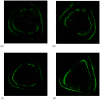Distinct cyclosporin a doses are required to enhance bone formation induced by cyclic and rest-inserted loading in the senescent skeleton
- PMID: 24404194
- PMCID: PMC3880323
- DOI: 10.1371/journal.pone.0084868
Distinct cyclosporin a doses are required to enhance bone formation induced by cyclic and rest-inserted loading in the senescent skeleton
Abstract
Age-related decline in periosteal adaptation negatively impacts the ability to utilize exercise to enhance bone mass and strength in the elderly. We recently observed that in senescent animals subject to cyclically applied loading, supplementation with Cyclosporin A (CsA) substantially enhanced the periosteal bone formation rates to levels observed in young animals. We therefore speculated that if the CsA supplement could enhance bone response to a variety of types of mechanical stimuli, this approach could readily provide the means to expand the range of mild stimuli that are robustly osteogenic at senescence. Here, we specifically hypothesized that a given CsA supplement would enhance bone formation induced in the senescent skeleton by both cyclic (1-Hz) and rest-inserted loading (wherein a 10-s unloaded rest interval is inserted between each load cycle). To examine this hypothesis, the right tibiae of senescent female C57BL/6 mice (22 Mo) were subjected to cyclic or rest-inserted loading supplemented with CsA at 3.0 mg/kg. As previously, we initially found that while the periosteal bone formation rate (p.BFR) induced by cyclic loading was enhanced when supplemented with 3.0 mg/kg CsA (by 140%), the response to rest-inserted loading was not augmented at this CsA dosage. In follow-up experiments, we observed that while a 30-fold lower CsA dosage (0.1 mg/kg) significantly enhanced p.BFR induced by rest-inserted loading (by 102%), it was ineffective as a supplement with cyclic loading. Additional experiments and statistical analysis confirmed that the dose-response relations were significantly different for cyclic versus rest-inserted loading, only because the two stimuli required distinct CsA dosages for efficacy. While not anticipated a priori, clarifying the complexity underlying the observed interaction between CsA dosage and loading type holds potential for insight into how bone response to a broad range of mechanical stimuli may be substantially enhanced in the senescent skeleton.
Conflict of interest statement
Figures




Similar articles
-
Enabling bone formation in the aged skeleton via rest-inserted mechanical loading.Bone. 2003 Dec;33(6):946-55. doi: 10.1016/j.bone.2003.07.009. Bone. 2003. PMID: 14678854
-
Rest-inserted loading rapidly amplifies the response of bone to small increases in strain and load cycles.J Appl Physiol (1985). 2007 May;102(5):1945-52. doi: 10.1152/japplphysiol.00507.2006. Epub 2007 Jan 25. J Appl Physiol (1985). 2007. PMID: 17255366
-
Rescuing loading induced bone formation at senescence.PLoS Comput Biol. 2010 Sep 9;6(9):e1000924. doi: 10.1371/journal.pcbi.1000924. PLoS Comput Biol. 2010. PMID: 20838577 Free PMC article.
-
Bone mechanotransduction may require augmentation in order to strengthen the senescent skeleton.Ageing Res Rev. 2012 Jul;11(3):353-60. doi: 10.1016/j.arr.2011.12.007. Epub 2012 Jan 5. Ageing Res Rev. 2012. PMID: 22240208 Free PMC article. Review.
-
Why rest stimulates bone formation: a hypothesis based on complex adaptive phenomenon.Exerc Sport Sci Rev. 2004 Jan;32(1):9-13. doi: 10.1097/00003677-200401000-00003. Exerc Sport Sci Rev. 2004. PMID: 14748543 Free PMC article. Review.
Cited by
-
Muscle paralysis induces bone marrow inflammation and predisposition to formation of giant osteoclasts.Am J Physiol Cell Physiol. 2017 Nov 1;313(5):C533-C540. doi: 10.1152/ajpcell.00363.2016. Epub 2017 Aug 30. Am J Physiol Cell Physiol. 2017. PMID: 28855162 Free PMC article.
-
An Invertible Mathematical Model of Cortical Bone's Adaptation to Mechanical Loading.Sci Rep. 2019 Apr 10;9(1):5890. doi: 10.1038/s41598-019-42378-5. Sci Rep. 2019. PMID: 30971812 Free PMC article.
-
Enhancement of Flow-Induced AP-1 Gene Expression by Cyclosporin A Requires NFAT-Independent Signaling in Bone Cells.Cell Mol Bioeng. 2014 Jun 1;7(2):254-265. doi: 10.1007/s12195-014-0321-3. Cell Mol Bioeng. 2014. PMID: 25484988 Free PMC article.
References
-
- Cooper C, Westlake S, Harvey N, Javaid K, Dennison E, et al. (2006) Review: developmental origins of osteoporotic fracture. Osteoporos Int 17: 337–347. - PubMed
-
- Seeman E (2001) Unresolved issues in osteoporosis in men. Rev Endocr Metab Disord 2: 45–64. - PubMed
-
- Hosking D, Chilvers C, Christiansen C, Ravn P, Wasnich R, et al. (1998) Prevention of bone loss with alendronate in postmenopausal women under 60 years of age. Early Postmenopausal Intervention Cohort Study Group. N Engl J Med 338: 485–492. - PubMed
Publication types
MeSH terms
Substances
Grants and funding
LinkOut - more resources
Full Text Sources
Other Literature Sources
Research Materials

